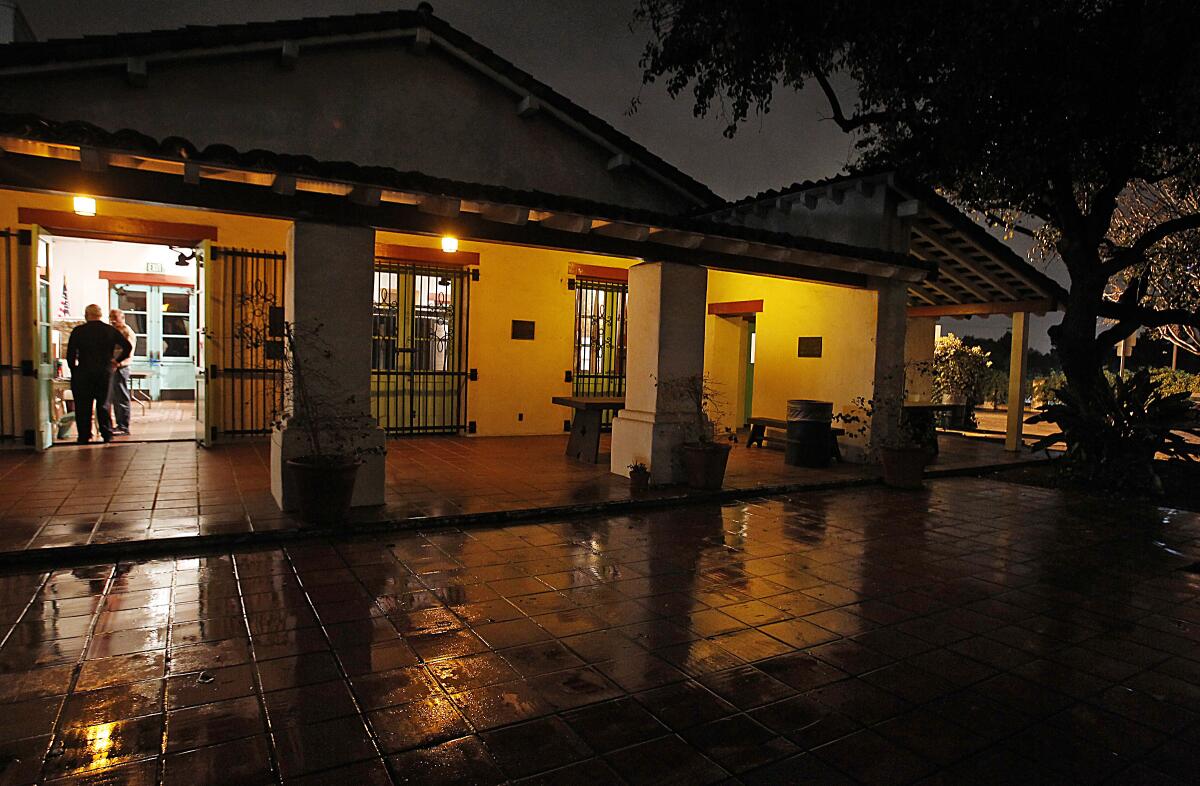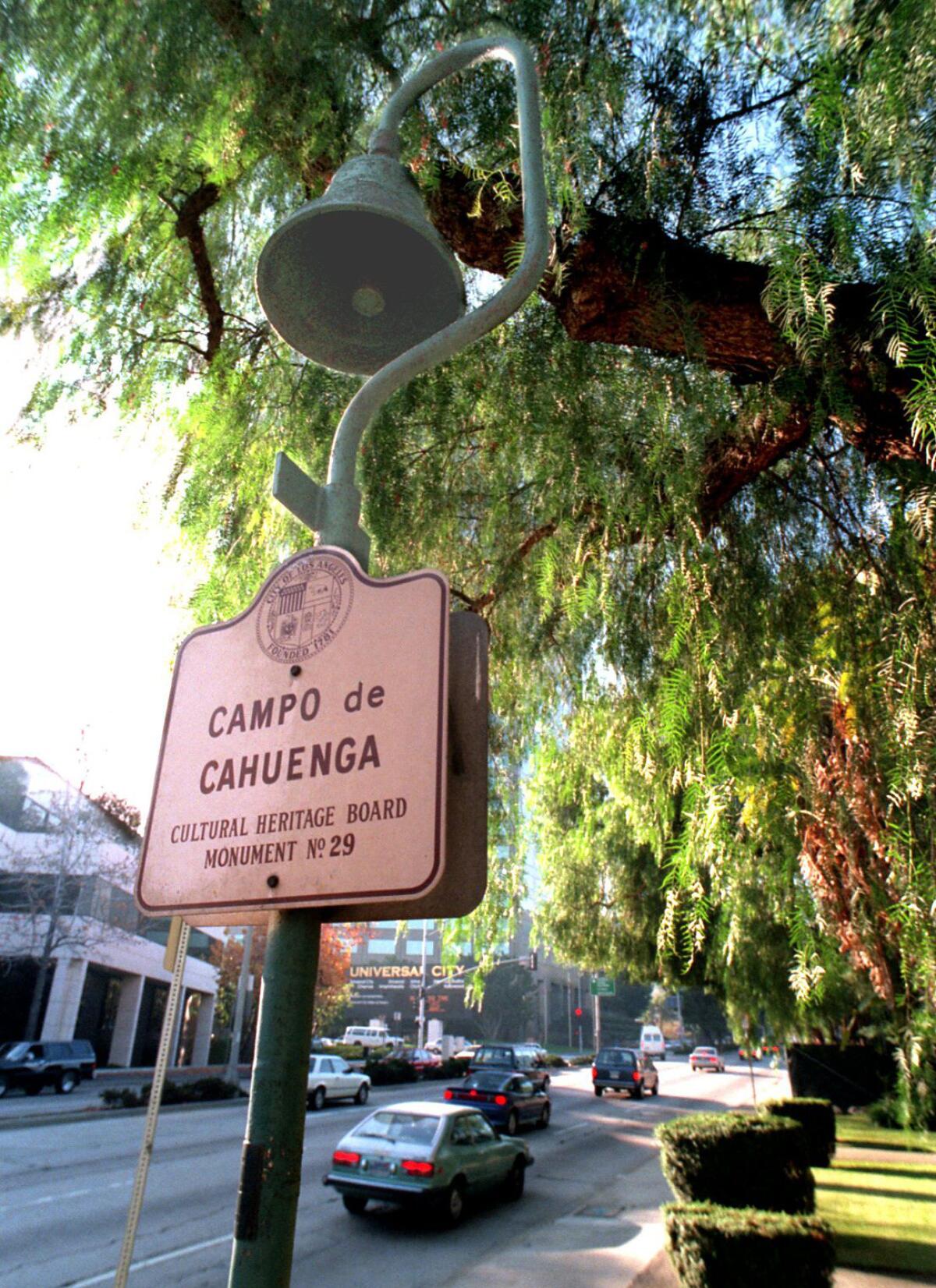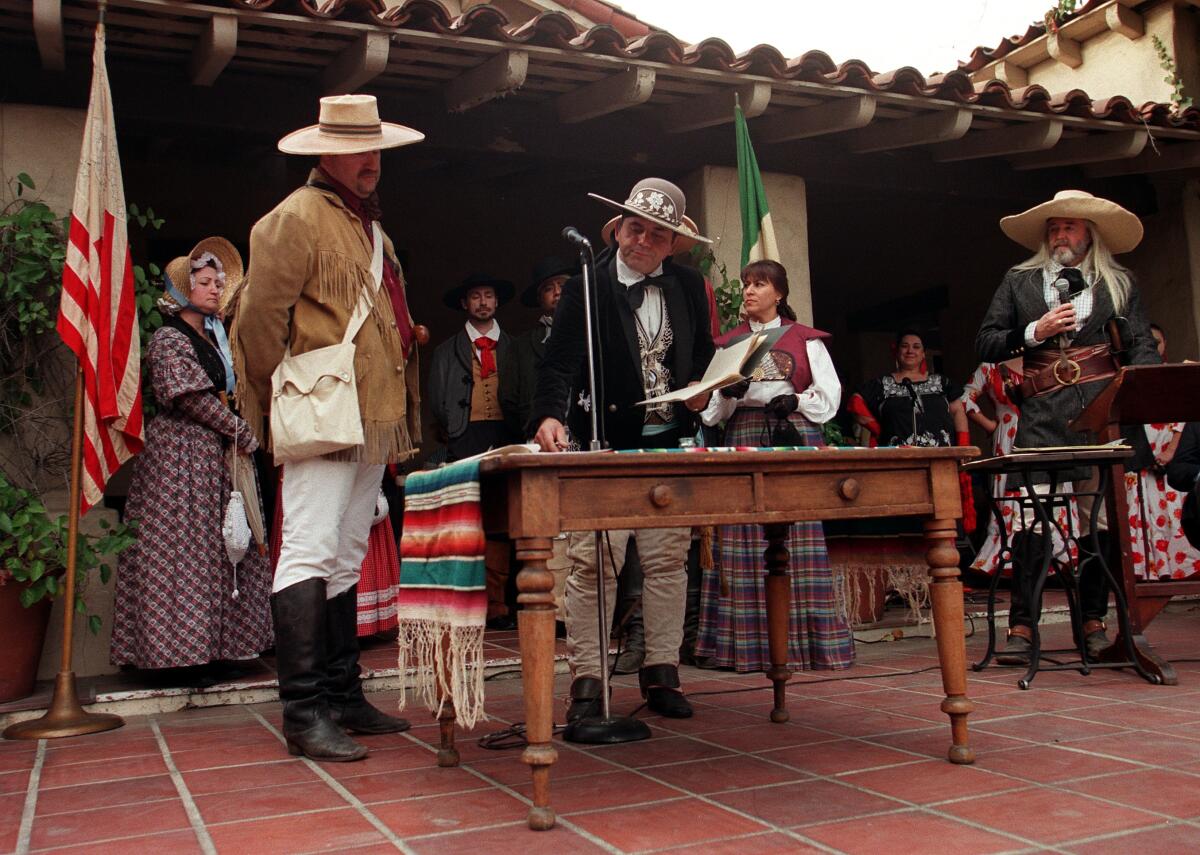At the L.A. site of an old cease-fire, looking for peace in an impolite society

- Share via
In this era of rancor and division and existential threats to our democracy and polite society — in a state that recently weathered a nasty gubernatorial recall attempt, in a Southland where violence now seems to be possible anywhere — I drove up to Studio City on a cloudy Saturday a couple of weeks ago to look for peace.
I went to Campo de Cahuenga, a small, lush, walled-off park across Lankershim Boulevard from Universal Studios and next to a Metro Red Line station. It has a lawn and trees and fountains and a replica adobe house filled with memorabilia from California’s Mexican era.
Signs in English and Spanish tell what happened here. On Jan. 13, 1847, invading Yankee forces and their Californio enemies signed the Treaty of Cahuenga. The cease-fire signified the end of fighting in Alta California during the Mexican-American War and signaled the beginning of the end of Mexican control over the American Southwest. It also promised Californios the same rights as American citizens and allowed them to keep their property.
“There was no fighting here, so we call it a place of peace, a place where people came together,” said Phyllis Hansen. She’s a board member of the nonprofit Campo de Cahuenga Historical Memorial Assn., and has volunteered since 2006 during their open houses, which are supposed to happen every first and third Saturday of the month.
Here at this spot in Studio City, peace lasted for little more than an afternoon. The Mexican-American War was a Manifest Destiny-fueled land grab that American luminaries like Abraham Lincoln and Ulysses S. Grant called “unnecessary” and “one of the most unjust ever waged.” Once California joined the Union, many of the Californios lost their lands and power.

But the promise of peace is one we should all take to heart because it’s so fragile. So what happened at Campo de Cahuenga took on an outsize role in how Southern California remembered its history.
In 1910, civic leaders placed an El Camino Real bell in front of the Campo. In 1923, the city of Los Angeles bought the land — by then used by an animal hospital — to turn it into a park. The year 1950 saw the opening of the current faux-adobe building and a rededication of the Campo’s status as a place to remember what this paper once called “the most important event in the history of the State.”
As the years went on, the Campo de Cahuenga Historical Memorial Assn. began to stage a historical reenactment of the treaty’s signing near the date of its anniversary.
“The purpose of our site is so people can know what happened here,” Hansen said. “There are all these connections woven through — women’s history, American history, Native American and Mexican history. It’s a reminder for how we were, and can be.”
Without Jose Antonio Carrillo, the birth of California as an American state would have been a much more labored event.
The last Treaty of Cahuenga reenactment, in 2020, was one of the biggest in a while. About 300 people showed up to hear speeches about the Mexican-American War. People dressed in mid-19th-century finery to depict soldiers, dons, and señoritas of the era. Replica tools and firearms were on display, including a replica cannon loaded with loud blanks someone eventually fired in the only act of violence in the afternoon.
The highlight, though, was when actors who portrayed U.S. Army Lt. Col. John C. Fremont and Mexican Gen. Andres Pico, the commanders of each side, offered words of genuine respect to each other for their respective stands. They then shook hands and signed the cease-fire.

I saw none of that profundity as I walked up to the Campo on the third Saturday of this month, two days after the Treaty of Cahuenga anniversary date. Instead, I saw a reminder of the times we live in.
The gates were closed. Plywood covered up windows in the front rooms of the adobe. A banner at the front that advertised free museum tours was torn up and tagged with graffiti. A faded flier on the wall next to the Metro station advertised the 2020 reenactment. Nearby, private security guards didn’t seem to notice that a man had scaled the Campo’s walls and spread his belongings on a table underneath the adobe’s veranda.
The Los Angeles Department of Recreation and Parks shut down the Campo in March of 2020, along with all parks across the city. Most eventually reopened in some capacity, but not the Campo. So not only was there was no Treaty of Cahuenga reenactment last year, but plans to commemorate its 175th anniversary this month — something that local history buffs have looked forward to long before the pandemic — went nowhere.
“It’s hugely disappointing,” said Hansen. “I can’t find any words other for it. It’s part of our [association] mission to keep this up.“
What particularly pains Hansen and her fellow board members is that they were working with the city to place a paid staffer at the Campo so it could be open five days a week for the first time in decades.
“We were on the edge of making it happen,” said Hansen. “Then coronavirus came along and torpedoed those plans. The city has never allowed us in to even open for an open house.”
Los Angeles Department of Recreation and Parks spokesperson Rose Watson confirmed all of this.
“As the department builds back staff capacity,” she said, “the prior staffing plan for the Campo de Cahuenga will be reassessed with the goal of supporting more access and more programming at the site when sufficient staffing is available.”
Watson added that there is no set date for the Campo’s reopening but that “staff is meeting monthly to reassess the Department’s operations.”
As the Department of Recreation and Parks dilly-dallies on the Campo’s reopening, other 175th anniversary commemorations for the Mexican-American War have happened across Southern California since the fall, with COVID-19 safety protocols — mandatory masking, social distancing, hand sanitizers — in place.
Fittingly, all these happenings involved fighting.
The Mexican-American War of remade the U.S. and Mexico — and the much-debated border that separates the two countries. But it remains a relatively overshadowed conflict in American history. In Montebello, a group of men and women try to educate people by reenacting a key battle.
The Dominguez Rancho Adobe Museum held festivities for the Battle of Dominguez Rancho, one of the few Mexican victories in the Mexican-American War, in October. The same happened in November at San Pasqual Battlefield State Historic Park in San Diego County, where Mexican forces led by Pico — who later on became a state Assembly member and senator — held the Americans to a stalemate. At the Juan Matias Sanchez Adobe in Montebello, the city’s historical society staged a reenactment of the Battle of Rio San Gabriel on Jan. 8, the second-to-last skirmish between Mexican and American troops in California.
The Treaty of Cahuenga staging “sets the pace for the whole year of local reenactment events,” said Kathleen Rabago, a Montebello Historical Society board member. She has participated in previous Treaty of Cahuenga ceremonies as Bernarda Ruiz, the Santa Barbara matron credited with helping to broker the cease-fire. “It’s just so sad to see it closed, especially for this year.”
“I don’t know if the Campo is in L.A.’s forefront or their agenda,” said Dominguez Rancho Adobe director Luis Fernández. “I think it should be on their agenda. It’s an important place, especially for its sense of unity. You become stronger that way.”
Hansen says the Campo association will hold a reenactment later this year, but she’s already “moving forward.” She has proposed that the group offer the reenactment of the Treaty of Cahuenga in virtual reality, an idea that she says other board members are “super jazzed” about. But she also hopes the city of L.A. can get back to what was planned for the Campo’s future right before the pandemic.
“We don’t want people to come just once a year,” she said. “We want them to come every day. Because what happened here is what made modern California.”
What happened at the Campo of Cahuenga was peace. For an afternoon.
More to Read
Sign up for Essential California
The most important California stories and recommendations in your inbox every morning.
You may occasionally receive promotional content from the Los Angeles Times.











